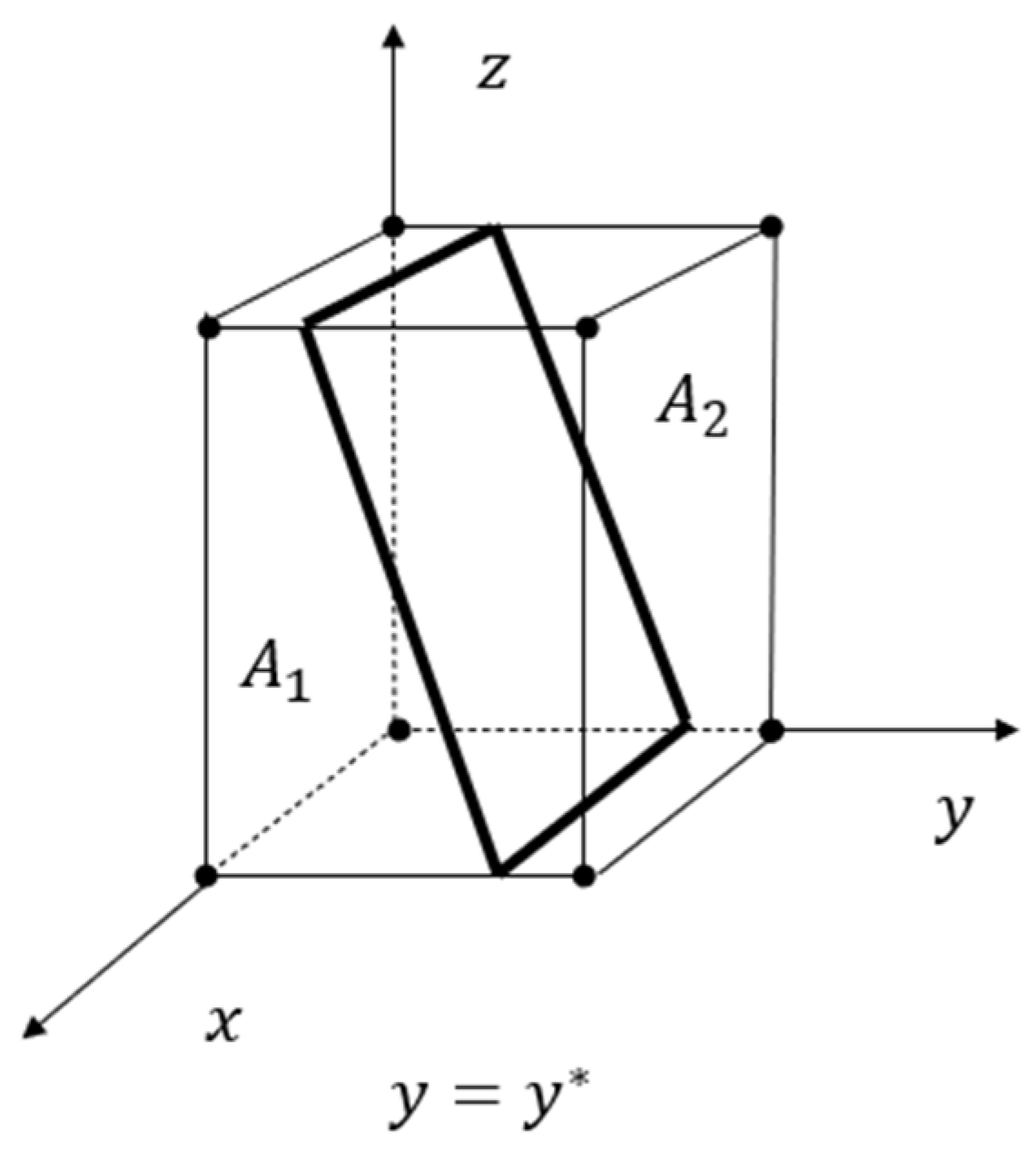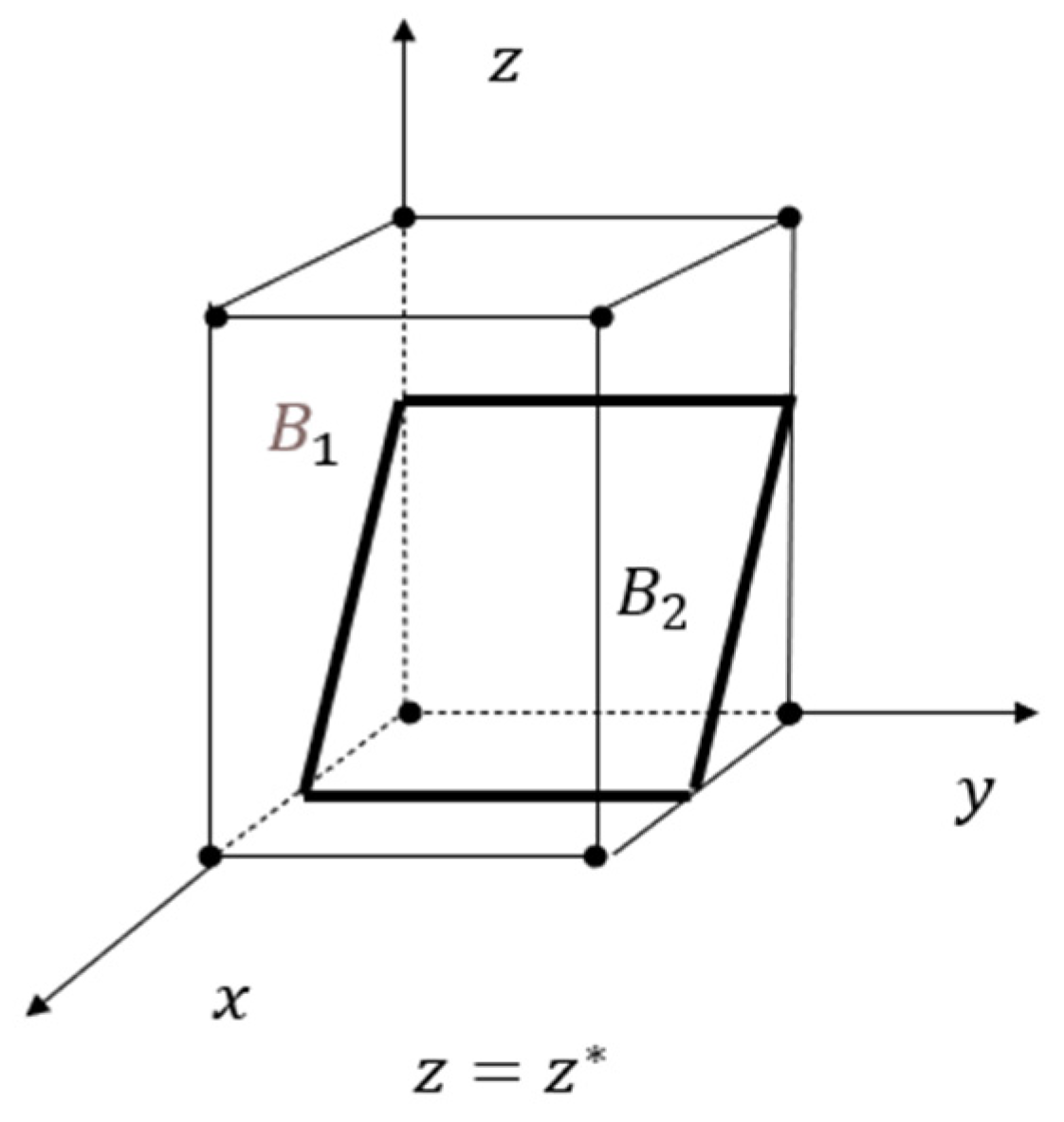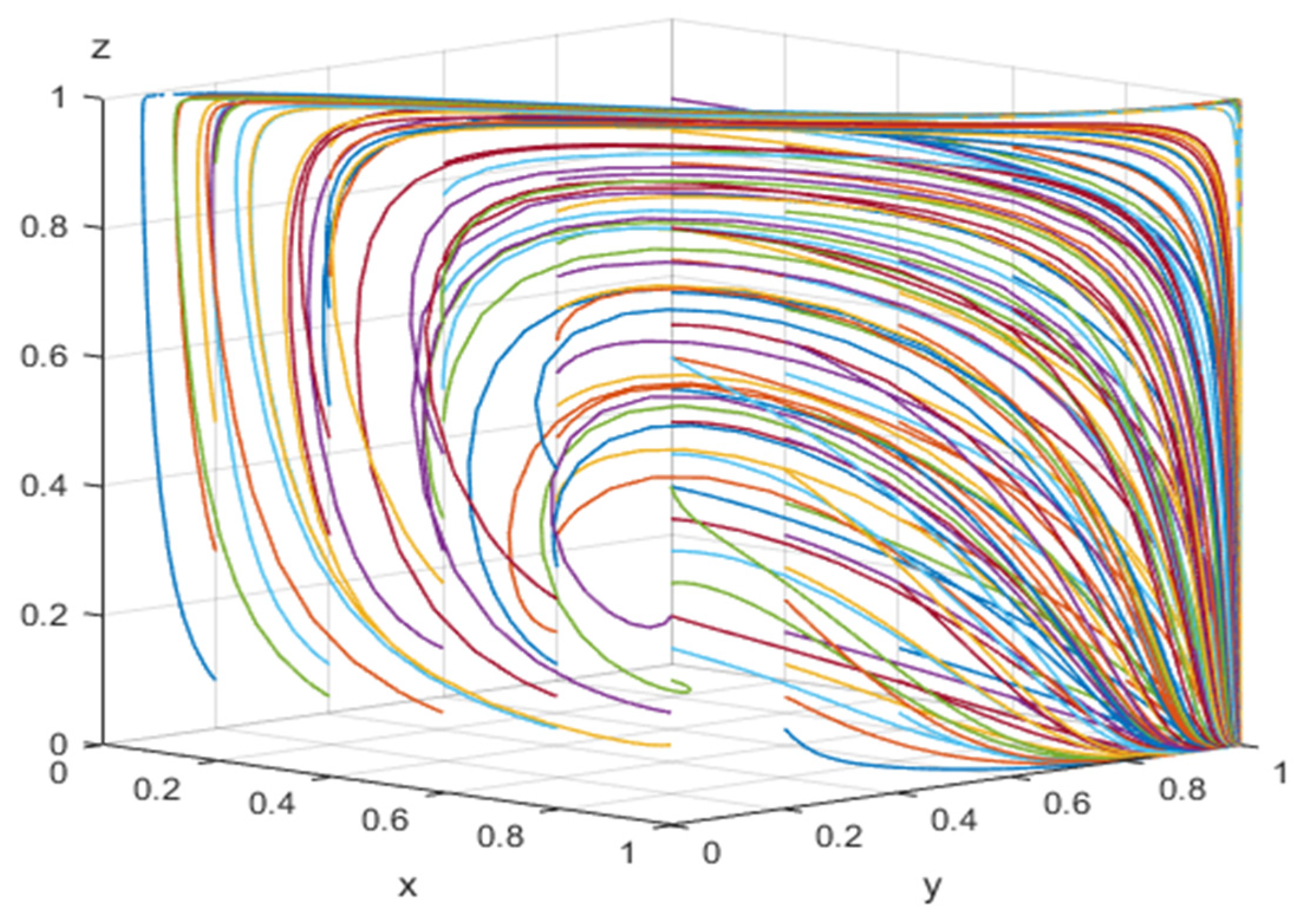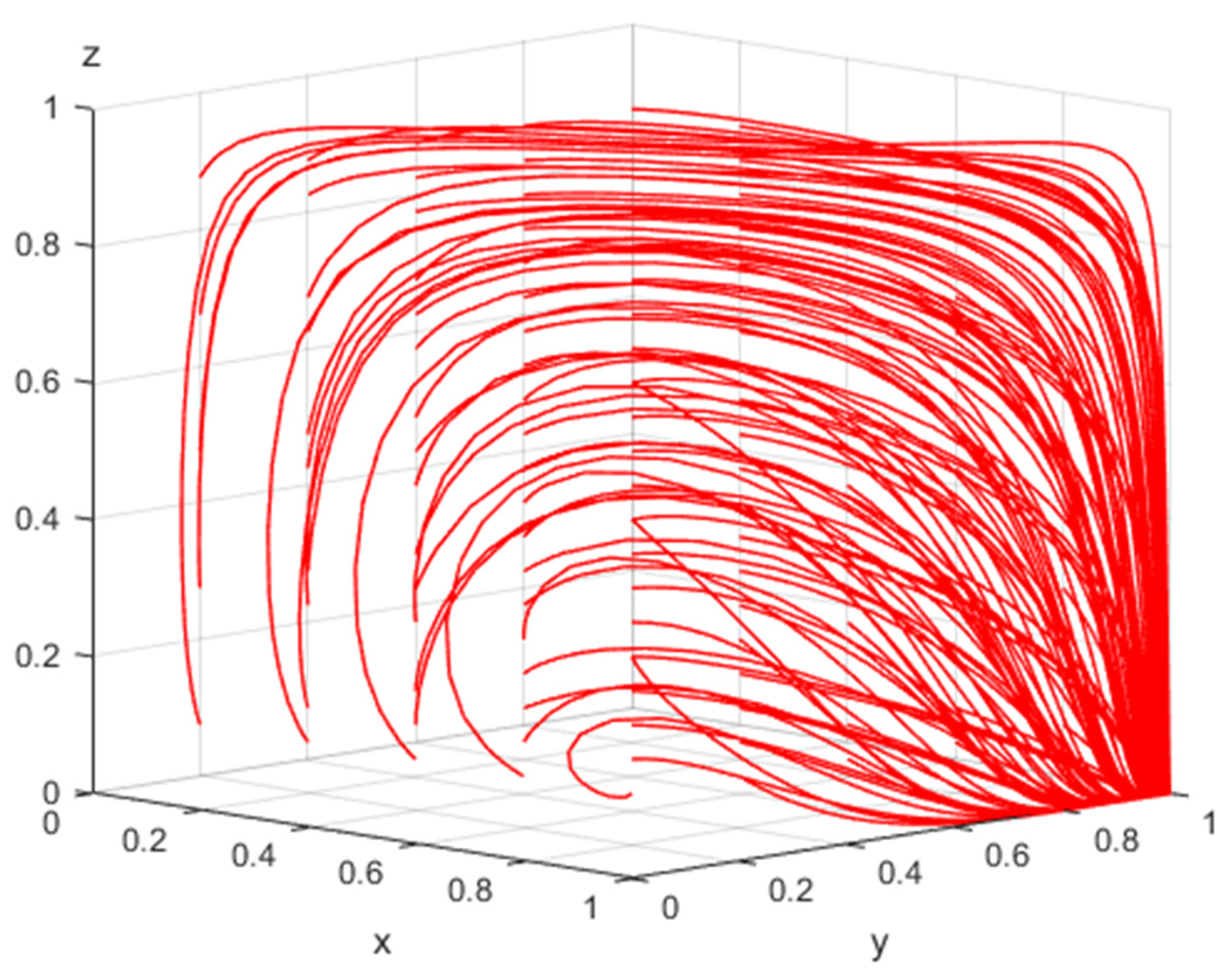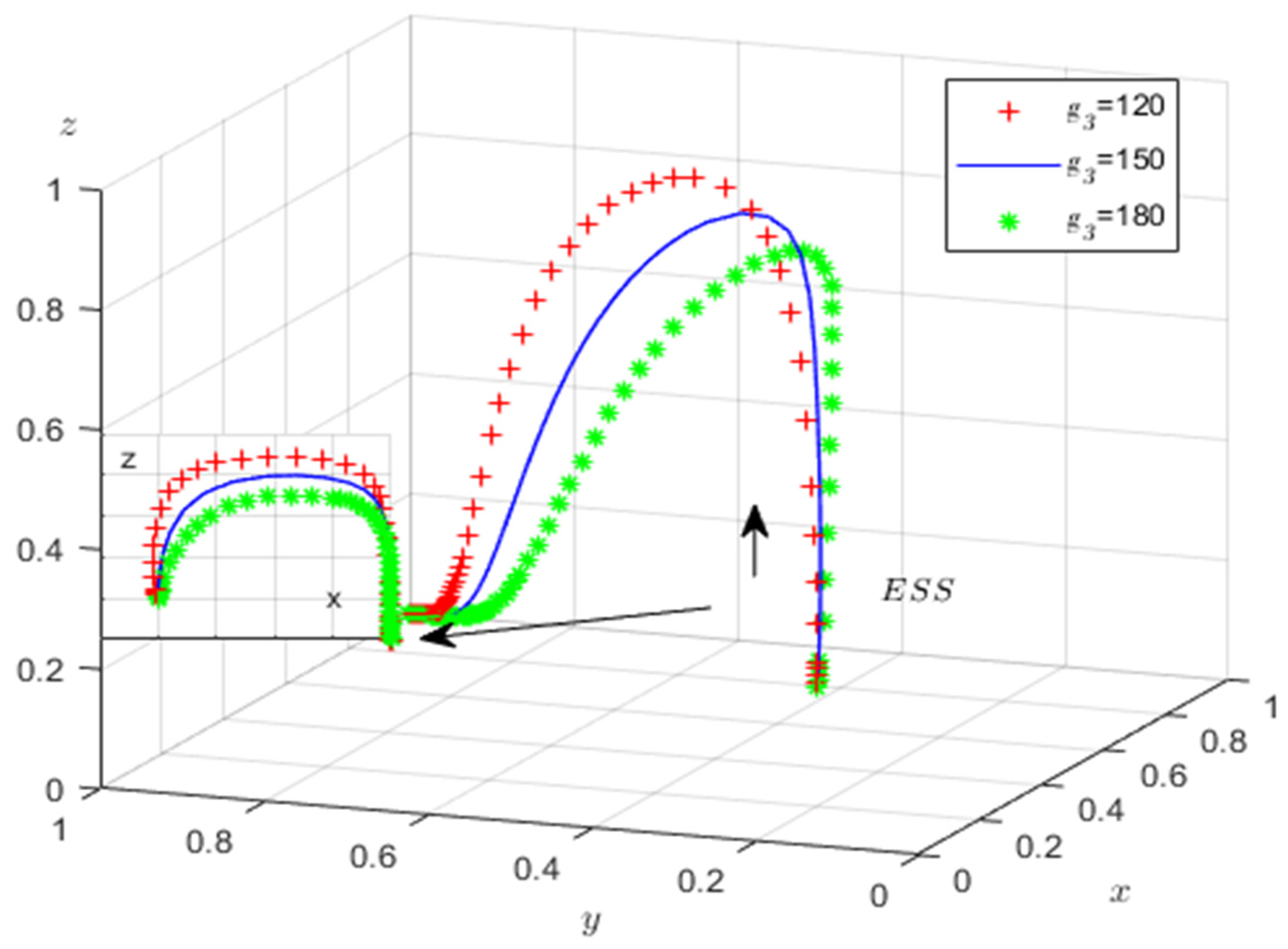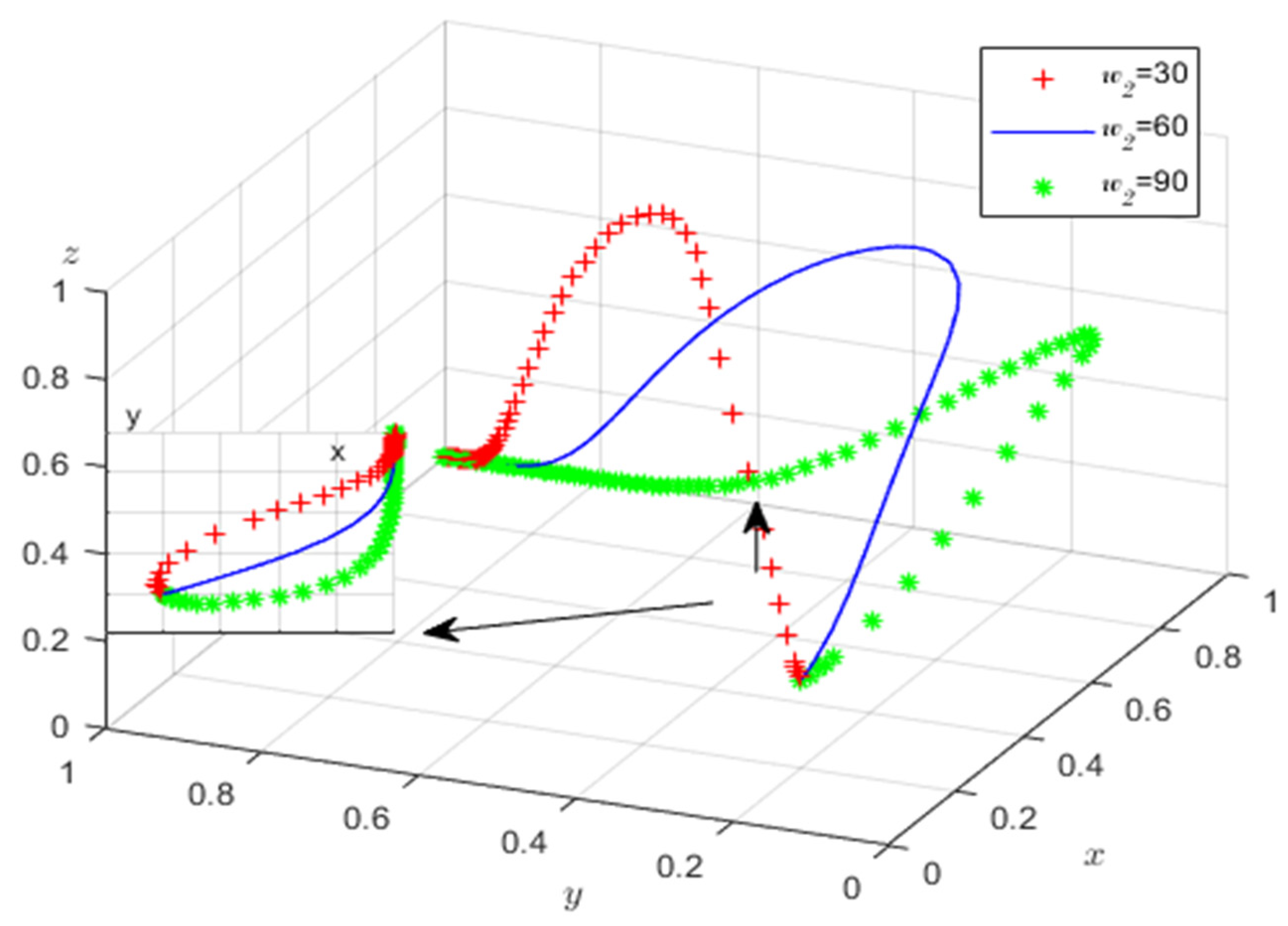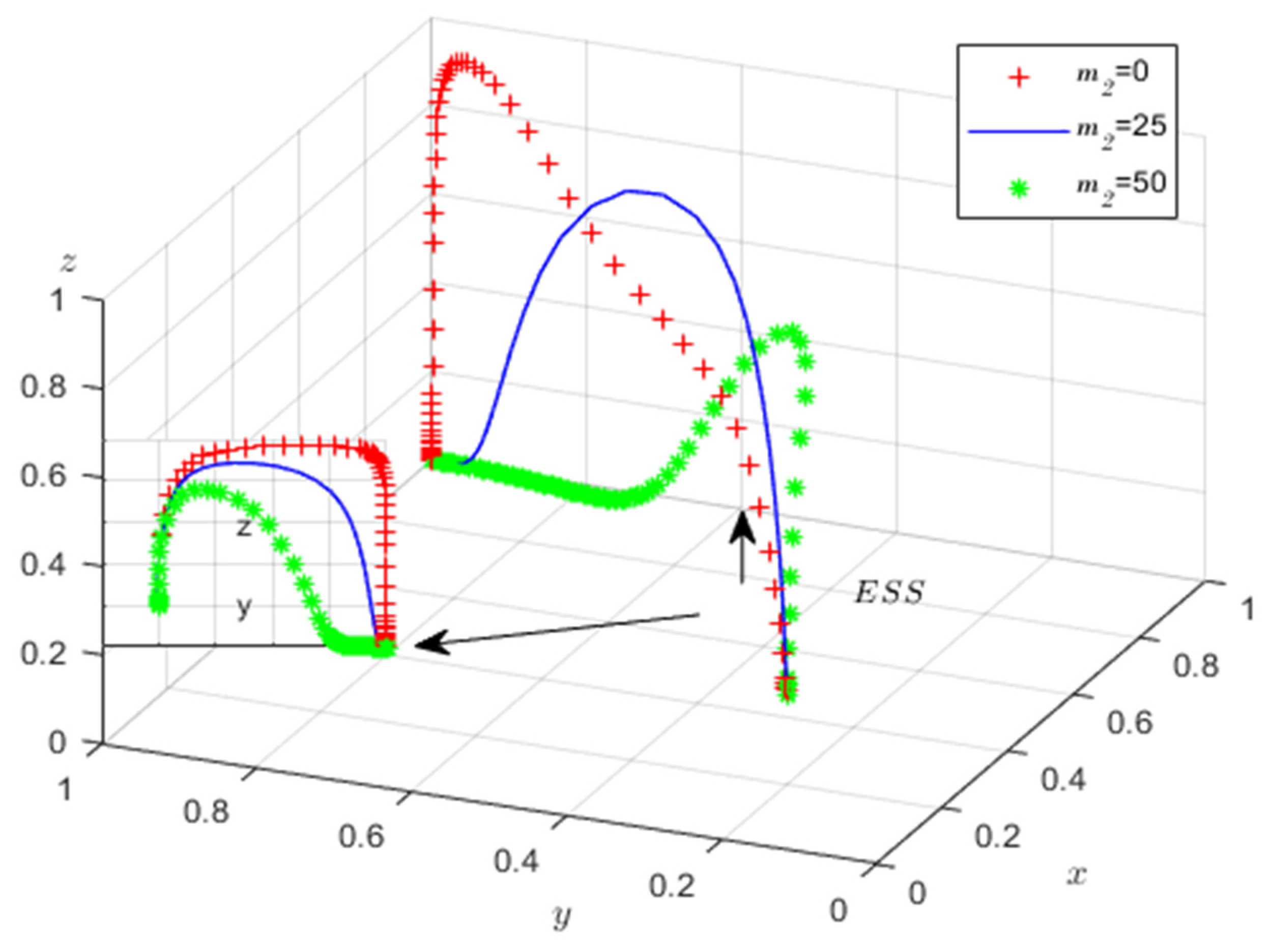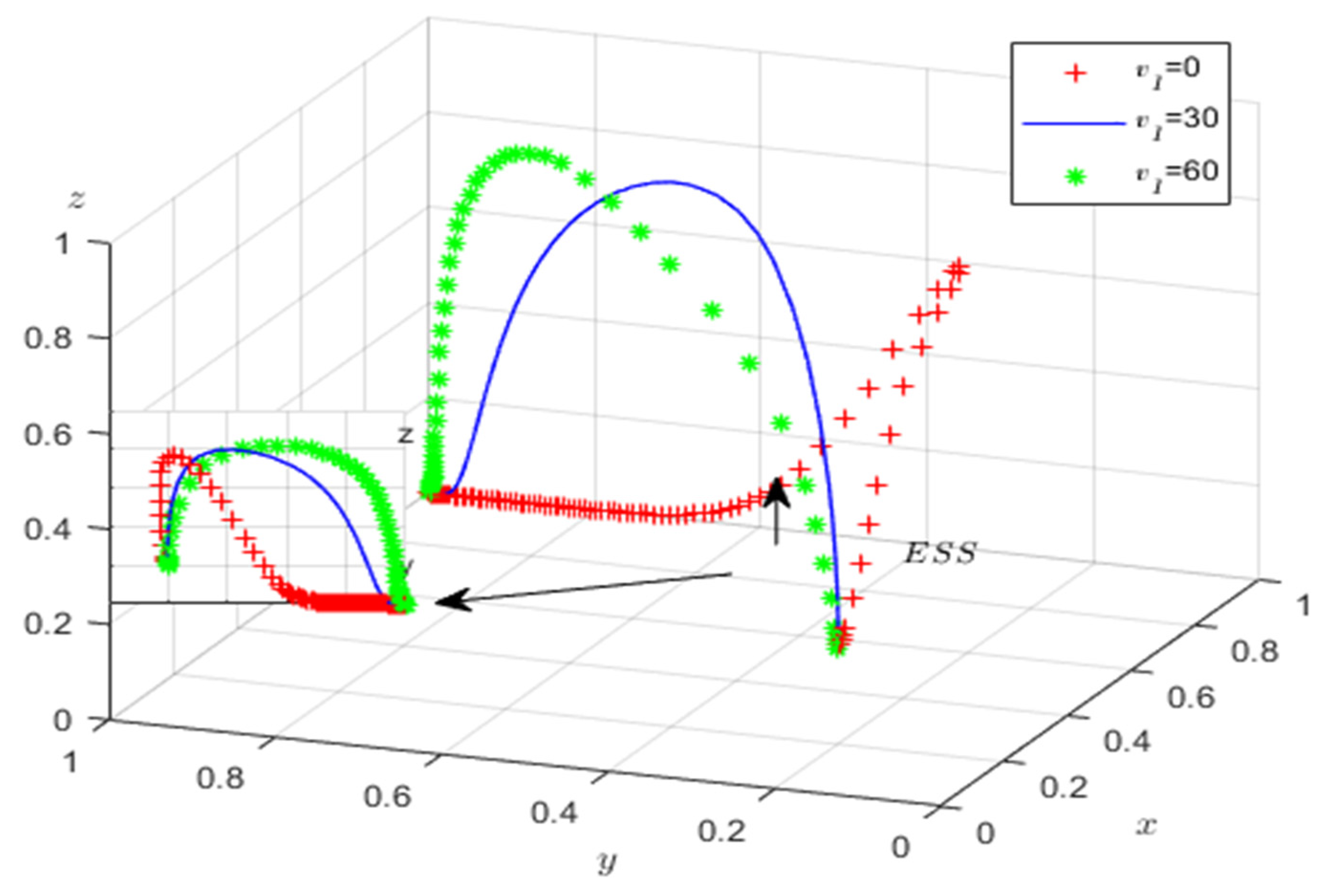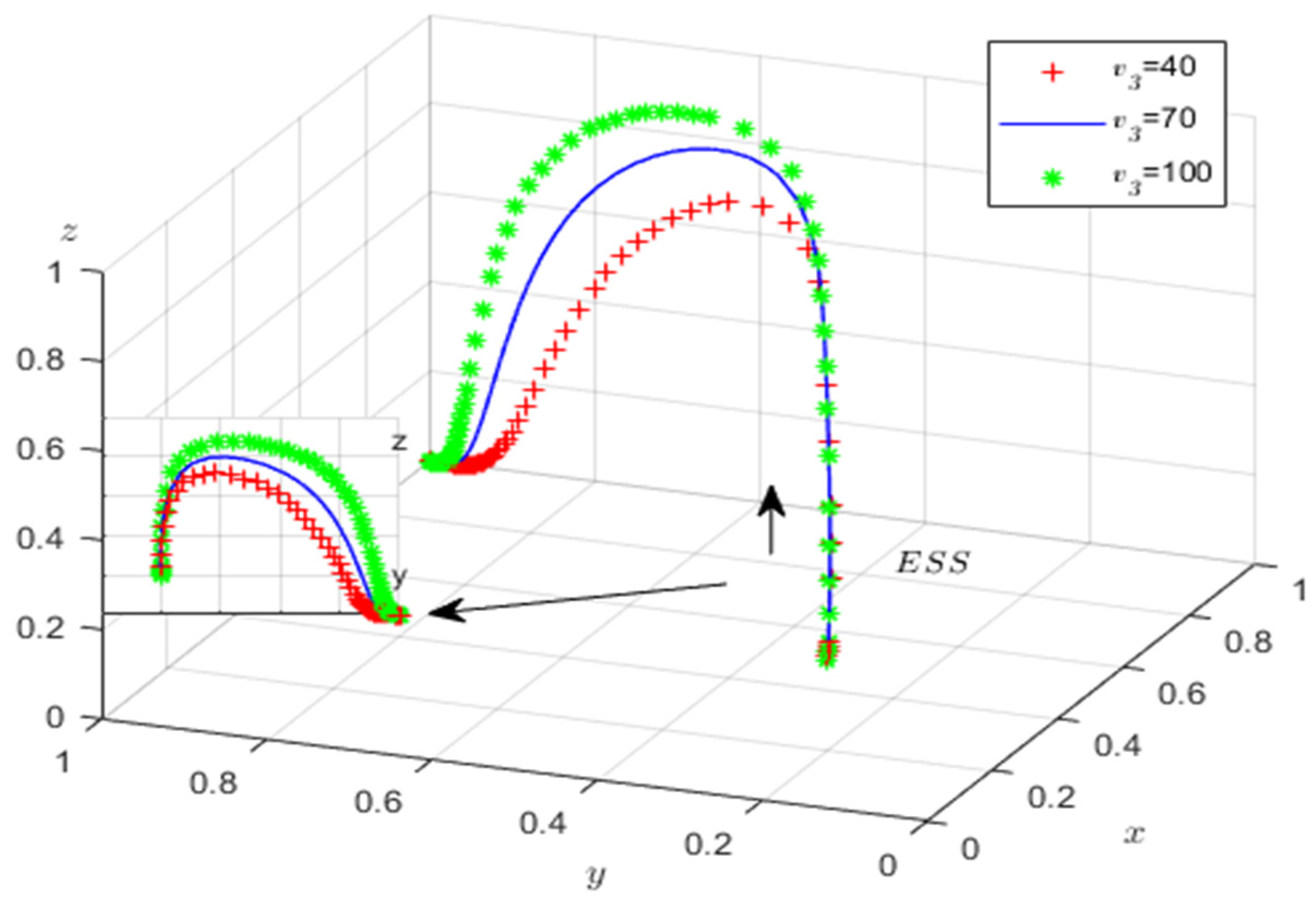4.1. Game Assumptions
There are many factors affecting the game strategy of the three parties, and a variety of internal and external factors will constrain the choice of game strategy of the three parties in the evolution of the game, in which the behavioral strategy of the subjects is constrained by each other’s and weighed against each other’s, and at the same time, they aim to maximize the sense of identity and benefits in their hearts. Therefore, in the study of the evolution of emergencies in the process of the behavior of the self-media, the media, and the government, the three participants should be taken into account.
Therefore, when studying the behavior of the self-media, media, and government during the evolution of emergencies, we should fully consider the costs and benefits of the three participants in choosing different strategies and formulating coping strategies based on the game in various scenarios. In this paper, the general assumptions of the model are set as follows:
Hypothesis 1. Participants in the evolution of emergencies in the government, media, self-media, and other game subjects are rational economic people; that is, to maximize their interests as the goal, the subjects are to consider their benefits and pay the cost of making changes in the game process of their strategies.
Hypothesis 2. The government, media, and self-media constitute the main body of the game of emergencies. During the evolution of emergencies, the government can choose “intervention” and “non-intervention” strategies, the media can choose “reporting” and “non-reporting” strategies, and the self-media can choose “participation” and “non-participation” strategies. The media can choose to “report” or “not report”, and the self-media can choose to “participate” or “not participate”. When an emergency breaks out, the government’s strategy set is and , and represents the intervention strategy while represents the strategy of non-intervention; the set of media reporting strategies are and , and represents adopting the reporting strategy while represents adopting the non-reporting strategy; the strategies of the self-media participation in the event discussion are and . represents choosing to participate in the strategy, while represents choosing not to participate in the strategy.
Hypothesis 3. The government is the central perspective to develop the hypothesis; when there is an emergency, the government’s timely choice of active strategy will be effective in mitigating the risk of emergency loss and brings benefits . In the process of actively responding to emergencies, the government needs to pay for the cost of time, workforce, and resources . The cost of time, workforce resources, etc., that the government has to pay for in the process of actively responding to the emergencies and the loss caused by the suppression of public opinion by the self-media is The negative impact of the evolution of the subjective behaviors of emergencies forwarded to the government by the media is The adverse effects of the government’s negative response. The suppression of public opinion by the self-media is The loss brought by the media to the government is . The negative impact of the government’s negative response, such as the decrease in credibility of the government, is .
Hypothesis 4. The media is the central perspective to develop the hypothesis; the media chooses to forward and report on emergencies; in the case of the self-media not participating in the case, the media’s information will not be concerned, assuming that its revenue is 0, but it will pay for a certain amount of time and energy and other costs . In the case of self-media participation, the media’s gain from reporting on the event of concern, such as the promotion of the platform, the increase in the number of users’ fans, the enhancement of reputation and other aspects of self-media attention, is 0, but it will pay for a specific cost of time and energy . The cost of time and energy is the same as the cost of time and energy . When the government chooses to respond positively, the reputation and fines incurred by the media as a result of the government’s constraints are, the rewards given by the government to the media are . If the media does not forward the information about emergencies, the self-media participation in the situation will cause an inevitable loss of .
Hypothesis 5. Taking the self-media as the central perspective, the self-media participation in the discussion of the emergencies will obtain psychological satisfaction or sense of identity and other benefits . The time cost for the media to report and reprint the information on emergencies so that the self-media can obtain more information is . When the media does not report and reprint the information, the time cost for the self-media to obtain more information through other ways is , that is, When the government responds positively, the self-media will obtain positive psychological benefits . When the government chooses a negative response strategy, the self-media will lose the psychological gap caused by their dissatisfaction with society and the government and the potential loss caused by participation in the discussion of the event .
Hypothesis 6. Self-media (disseminator) behavioral strategies are assumed to be divided into participation and non-participation. If the self-media’s involvement in public opinion dissemination obtains higher benefits, they will participate, and vice versa, they will not participate. Suppose their probability of participation is set as x and the non-participation probability is set as . When , when the probability of involvement is x, the probability of non-participation is x. When the probability of non-participation is , it means the self-media must not participate. The media’s (publisher’s) behavioral strategies are divided into reporting and non-reporting. Suppose the benefit of reporting the speech of critical-incident online public opinion is greater than the reporting cost. In that case, the media chooses to report, and vice versa, it decides not to report. The probability of reporting is set as , and the probability of not reporting is set as . When , it means that the media will report it; when , it means the media must not report. Government (controller) behavioral strategies are divided into intervention and non-intervention. The government does not intervene for various reasons, such as not obtaining the risk and cost of public opinion intervention due to pre-preparation. The intervention probability is set as, and the probability of non-intervention is set as . When , the government intervene; when the government will not intervene, .
Hypothesis 7. This paper further analyzes the behavioral decision-making of the government, media, and self-media in-depth and systematically, and based on the interactions between the three subjects in the evolution of emergencies, the relationship between the three subjects and the factors affecting them, the parameters of the interactions between the three subjects are derived, as shown in Table 1 below.
4.3. Modeling Analysis
1. Strategic stability analysis of self-media (disseminator)
The expected benefits of the self-media (disseminator) participation or non-participation in online opinion outbreaks and the average expected benefits (
,
, and
), respectively:
The equation for the replication dynamics chosen by the self-media (disseminator) is:
The first derivative of
and the set
are:
According to the stability theorem of differential equations, the probability of the self-media (disseminator) choosing to participate in the discussion of public opinion on emergencies in a stable state must be satisfied: and . Since , is the probability of participating in the public opinion discussion of a critical incident with respect to , the reduced function. Therefore, when currently, is a constant equal to 0; the self-media (propagator) cannot determine the stabilization strategy. When , , currently, , and is the evolutionary stable strategy (ESS) of the self-media (propagator); vice versa. is the ESS. represents the critical probability of self-media strategy selection. represents the critical probability of strategic choices made by other relevant groups, such as governments or media.
The phase diagram of the strategy evolution of the self-media (disseminator) is shown in
Figure 2 below:
From
Figure 2, the probability of the self-media (disseminator) not participating in the dissemination of public opinion on emergencies is
. The volume of
and the likelihood of participating in the dissemination of public opinion on emergencies is
; the volume of
is calculated as follows:
Corollary 1. The probability of the self-media (disseminator) participating in the dissemination of public opinion on emergencies is positively correlated with the gains the self-media gain by choosing to participate, the positive psychological gains the self-media gain when the government responds positively, the losses the self-media incur when they respond negatively to emergencies, the damaging psychological losses the self-media incur when the government reacts negatively, and the costs the self-media pay when they participate in public opinion.
Proof. According to the probability of the self-media (disseminator) participating in the dissemination of public opinion on emergencies , calculating the first partial derivatives of each element. Conclusion: An increase in , and , as well as a decrease in , and , will increase the probability of self-media participating in online opinion discussions. □
Corollary 1 shows a positive correlation between whether the self-media will participate in the discussion of public opinion on emergencies and whether they can benefit from it, which is consistent with the rational broker hypothesis in the previous section. Usually, the self-media need to gain a sense of identity and practical benefits from participating in online public opinion on emergencies, which is the main reason that drives the self-media to disseminate their views. On the other hand, the government’s behavior mainly influences whether the self-media participates. Suppose the government responds positively and introduces reward and punishment policies and incentives. In that case, the self-media will be motivated to participate in the discussion so that the self-media will obtain additional positive benefits, and the possibility of participating in the debate will be increased accordingly; on the other hand, if the government responds negatively, it will bring adverse losses to the self-media, and the self-media will reduce their participation in the discussion. On the contrary, the government’s negative response will bring adverse losses to the self-media, and the self-media will consciously reduce their involvement in public opinion, which shows that the government’s adjustment of its intervention strategy can influence the self-media’s game choices. In this process, the self-media’s negative response to emergencies may also cause losses in their interests, and the more significant these losses are, the more the self-media will actively participate in the discussion of public opinion on emergencies, which is consistent with the previous hypothesis.
Corollary 2. The probability of the self-media (disseminator) disseminating public opinion on emergencies rises with the media reporting on emergencies and the likelihood of government intervention in public opinion on emergencies.
The proof, from the analysis of the stability of the self-media’s (disseminator’s) curation, is that when , , . , then is an evolutionary equilibrium strategy; conversely, is the evolutionary equilibrium strategy. Therefore, as , gradually increase, the stabilization strategy of the self-media (participants) increases from (not participating in critical-incident online public opinion discussion) to (participating in critical-incident online public opinion discussion).
Corollary 2 shows that media reports have positive incentives for the self-media to participate in public opinion discussions, media reports will reduce the cost of the self-media searching for information on their own, and truthful reports will reduce the likelihood of propagating false information among the population. Therefore, ensuring positive guidance of public opinion by the media can effectively enhance the truthfulness of public opinion dissemination in emergencies. Similarly, appropriate government intervention is also necessary to guide public opinion to the right path and provide confidence and support for the self-media to spread positive public opinion. Thus, when an emergency needs to be solved by the power of the self-media’s public opinion, positive media reports and timely and appropriate government guidance can encourage self-media participation.
2. Strategic stability analysis of the media (publisher)
Expected benefits of the media (publisher) reporting or not reporting on online opinion outbreaks and the average expected benefits (
,
), respectively:
The equation for the replication dynamics chosen by the media (publisher) is
The first-order derivative
and the settings of
, respectively:
According to the stability theorem of differential equations, the probability that the media (publisher) chooses to participate in the discussion of public opinion on critical incidents is in a steady state must be satisfied: and . Since , is a decreasing function with respect to , the reduced function. Therefore, when , ; at this time, is constant equal to 0; the media (publisher) cannot determine a stabilization strategy when ;. Currently, is the evolutionarily stable strategy (ESS) of the media (publisher) when is the ESS. represents the critical probability of government (regulator) strategy selection.
The phase diagram of strategy evolution for the media (publisher) is shown in
Figure 3 below:
From
Figure 3, the tangent crosses the point
−
, where
is the volume of
, which is the probability that the media (publisher) chooses not to publish the critical-incident public opinion.
is the volume of
, the probability that the media (publisher) choose to publish the breaking-news public opinion, which is calculated as follows:
Corollary 3. The probability of the media (publisher) participating in the dissemination of public opinion on emergencies is positively correlated with the benefits of self-media participation in positive media reporting, the incentives given by the government when the media responds positively, and the reputational damage and fines faced by the government when it responds positively but the media does not pay attention to the report. It is negatively correlated with the losses incurred by the media’s passive response and the costs of the media’s choice to pay attention to the report and the government’s positive response. The costs of time and effort paid by the media when the self-media do not participate and the reputational damage and fines faced by the government when it responds positively and the media does not pay attention to the reports are negatively correlated.
Proof. According to the probability of the media (publisher) to publish the online opinion of a critical incident , a conclusion is drawn by finding the first-order partial derivatives of each element of the expression of , , and increasing and , , and decreasing, leading to an increase in the probability of self-media participation in online opinion discussions. □
Inference 3 shows that whether the media (publisher) will participate in the publication of critical-incident online public opinion is positively correlated with the gain gained from positive reporting and negatively correlated with the loss incurred from the negative response, which is consistent with the assumption of the rational broker in the previous section that the media will choose the path of maximizing their interest in their decision-making. Both the government and self-media play a role in the media’s choice of whether to report on critical-incident online public opinion. On the one hand, the probability of media reporting is positively correlated with the policy incentives given by the government, i.e., the higher the level of government incentives and support, the more proactively the media will participate in the reporting of online public opinion, and on the contrary, the stronger the government-based punitive measures are when the media responds negatively, the more proactively the media will report on public opinion as well. On the other hand, the higher the cost of time and energy paid by the media when the self-media does not participate in disseminating public opinion, the less likely the media will choose to report it. Encouraging the self-media to actively join in the discussion of public opinion on emergencies can share the pressure of the media’s cost in reporting emergencies and make them more motivated to participate in releasing public opinion on emergencies on the Internet.
Corollary 4. The probability of the media (publisher) reporting on critical-incident online public opinion during the evolutionary process increases with the self-media’s participation in critical-incident online public opinion or the probability of government intervention in critical-incident online public opinion.
Proof. From the analysis of the curatorial stability of the media (publisher), when , when is the ESS; when , when is the ESS. □
Therefore, as increases, the probability that the media (publisher) will engage in critical-incident online opinion reporting increases.
Corollary 4 shows that the participation of the self-media in the dissemination of online public opinion on emergencies will have positive incentives for the media to publish relevant reports; the more the self-media participate in the discussion, the more the media gain when publishing news, the lower the average cost of dealing with matters in the process of publishing news, the higher the sense of identity the media can obtain, and the more they will take the action of positively publishing news, which is in line with the conclusions of Corollary Three. This is consistent with the conclusion of Corollary Three. The more the government actively adopts the strategy of intervening in the online public opinion of emergencies, the more the media will actively report the relevant events. As an intervener and regulator, the government’s movement can significantly impact the evolution of emergencies. At the same time, the government’s rewards and punishments are also closely related to the self-interests of the relevant media. Therefore, this paper concludes that when it is necessary to utilize the power of the media to positively guide the online public opinion of emergencies, the government’s active intervention and the enhancement of the self-media’s attention to the events are effective measures.
3. Analysis of the strategic stability of the government (regulator)
The expected benefits of the government’s (regulator’s) intervention or non-intervention in online public opinion emergencies and the average expected benefits (
,
,
), respectively:
The replication dynamic equation chosen by the government (controller) is
The first-order derivative
and the settings of
, respectively:
According to the stability theorem of differential equations, the probability that the government (controller) chooses to participate in the discussion of public opinion on emergencies is in a steady state must be satisfied: and . Since , then is a function with respect to , the reduced function. Therefore, when , ; at this time, is a constant equal to 0. The self-media (propagator) cannot determine a stabilization strategy when , ; at this time, is the self-media’s (propagator’s) evolutionarily stable strategy (ESS); conversely, is the ESS. represents the critical probability of strategy selection by other relevant groups (such as self-media or the media), which determines whether the government chooses to participate in the evolution of stable strategies for controlling online public opinion events.
The phase diagram for the evolution of the government’s (regulator) strategy is shown in
Figure 4 below:
From
Figure 4, the probability that the government (regulator) is not involved in the dissemination of public opinion on emergencies is
, the volume of
, and the probability of participating in the dissemination of public opinion on emergencies is
, the volume of
, which is calculated as:
Corollary 5. The probability that the government (regulator) is involved in the dissemination of public opinion in emergencies is positively related to the gains gained from the government’s choice of a positive strategy, the losses incurred from the government’s negative response, the suppression of public opinion by the self-media for the government’s negative response, and the losses brought about by the adverse reaction of the government to the media forwarded to the government, and it is negatively correlated with the degree of the public opinion suppression of the government’s positive response by the self-media, the degree of negative impacts brought about by the positive response of the government, the negative impacts brought about by the positive reaction from the government, the positive response of the government, and the negative impacts forwarded to the government by the media. Negative correlation.
Proof. Based on the probability of government (regulator) involvement in the propagation of public opinion on emergencies , the conclusion is drawn by finding the first-order partial derivatives of each element of the expression of and . , increase; and decrease, all leading to an increase in the probability of self-media participation in online opinion discussions. □
Corollary 5 shows that whether the government (regulator) will intervene in a critical incident online, public opinion is positively correlated with the gains it gains from its actions and negatively correlated with the losses incurred from its negative response, which is consistent with the assumption of the rational broker in the previous section. The government (regulator) will decide to maximize its interests. When the government responds negatively to network public opinion emergencies, other parties involved will make corresponding decisions because of their interests: the self-media will disseminate negative remarks about the government controller, and the media will publish reports about the government’s inaction, which is not conducive to the increase in the psychological identity of the government controller. At the same time, it will reduce the credibility of the government to a certain degree, and the more the self-media and the media negatively pressure the government, the more the government will actively intervene in the situation. When negative pressure from the self-media and the media increases, the government will take a more active intervention, directly proportional to each other. On the other hand, the government’s intervention measures in the active response process still need to meet the expectations of the self-media and the media entirely. To a certain extent, they may harm the interests of other game subjects so that the self-media may suppress the government’s actions. The press may negatively affect the government when forwarding the relevant remarks. The stronger the social intervention, the less likely the government will actively take measures to control public opinion on emergencies. Therefore, whether the government can actively predict and control the negative impacts of its control actions is a crucial consideration for the government before taking control measures.
Corollary 6. The probability that the government (regulator) is involved in disseminating public opinion on emergencies increases with the media’s reporting on emergencies and the likelihood of the self-media disseminating public opinion on emergencies.
Proof. From the stability analysis of the government’s (regulator’s) policy, when and , and , is the evolutionary equilibrium strategy. On the contrary, z = 1 is the evolutionary equilibrium strategy. Therefore, as x, y gradually increases, the stabilization strategy of the government (controller) increases from (intervening in critical-incident online public opinion) to (not intervening in critical-incident online public opinion). □
Corollary 6 shows that when there are more self-media participants and media participants in the game environment, the probability that the government will participate in the game and intervene in the online public opinion of emergencies promptly will increase because the self-media and the media have a higher degree of autonomy in their speeches. When they express their views or release the news, they will disseminate information about emergencies from various perspectives, which is redundant. They may contain both truthful and distorted information, so the government will take control measures when the number of participants increases. Therefore, when the number of participants increases, the government will take control measures. On the other hand, considering the status of the self-media and media as rational brokers, the government should take control measures to prevent them from strolling false information for profit. Therefore, when the scope of online public opinion on emergencies is broad and the number of subjects involved is large, the government should participate promptly and take control measures to avoid the development of public opinion in an uncontrollable direction.

